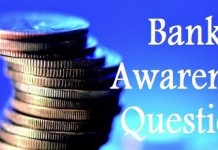Hello Aspirants,
Welcome to Banking Awareness Quiz in AffairsCloud.com. Here we are creating quiz covering important questions which are common for all the bank exams and other competitive exams.
- SEBI is a/an ________
A. Constitutional body
B. Advisory body
C. non-statutory body
D. Statutory body
E. None of the AboveD. Statutory body
Explanation:
Initially SEBI was a non statutory body without any statutory power. However, in 1995, the SEBI was given additional statutory power by the Government of India through an amendment to the Securities and Exchange Board of India Act, 1992. - Which of the following policies is known as Annual Policy Statement?
A. Annual budget of central government
B. Credit and Monetary Policy of RBI
C. Foreign trade policy of DGFT
D. Regulations issued by SEBI
E. None of the AboveB. Credit and Monetary Policy of RBI
Explanation:
Credit and Monetary Policy of RBI is known as Annual Policy Statement. - Which of the following is the Regulator of the credit rating agencies in India ?
A. RBI
B. SEBI
C. SIDBI
D. GOI
E. None of the AboveB. SEBI
Explanation:
The capital market regulator regulates rating agencies in most regions. In India, the capital markets regulator, the Securities and Exchange Board of India (SEBI), regulates the rating agencies in the country. - Securities Appellate Tribunal is a/an __________ established under the provisions of Section 15K of the Securities and Exchange Board of India Act, 1992
A. Constitutional body
B. Advisory body
C. non-statutory body
D. Statutory body
E. None of the AboveD. Statutory body
Explanation:
Securities Appellate Tribunal is a statutory body established under the provisions of Section 15K of the Securities and Exchange Board of India Act, 1992 to hear and dispose of appeals against orders passed by the Securities and Exchange Board of India. - Which of the following is a function of SEBI?
A. to approve by−laws of stock exchanges.
B. inspect the books of accounts of financial intermediaries.
C. to require the stock exchange to amend their by−laws.
D. compel certain companies to list their shares in one or more stock exchanges.
E. All of the AboveE. All of the Above
Explanation:
Function of SEBI:
To approve by−laws of stock exchanges.
Inspect the books of accounts of financial intermediaries.
To require the stock exchange to amend their by−laws.
Compel certain companies to list their shares in one or more stock exchanges. - The Monetary Authority in India, viz Reserve Bank of India is bound to maintain a reserve against the notes issued, Whatever may be the mount. This system is called as __________
A. Minimum Reserve System
B. Proportional Reserve System
C. Maximum Fiduciary Issue system
D. Simple deposit system
E. None of the AboveA. Minimum Reserve System
Explanation:
The RBI follows a minimum reserve system in the note issue. Initially, it used to keep 40 per cent of gold reserves in its total assets. - Which of the following services is NOT provided by the post offices in India ?
A. Savings Bank Scheme
B. Retailing of Mutual Funds
C. Sale of stamp Papers (Judicial)
D. Issuance of Demand Drafts
E. Life Insurance coverD. Issuance of Demand Drafts
Explanation:
Issuance of Demand Drafts is NOT provided by the post offices in India. - Credit rating _______
A. is used to rate the borrowers while giving advances
B. is used to work out performance of the employees
C. is used to calculate the number of excellent audit rated branches
D. is not used in any bank
E. is necessary before giving promotion to employeesA. is used to rate the borrowers while giving advances
Explanation:
Credit rating is an analysis of the credit risks associated with a financial instrument or a financial entity. An assessment of the creditworthiness of a borrower with respect to a particular debt or financial obligation. - The section 4 of the Negotiable Instruments Act, 1881 deals with ________
A. Cheque
B. Bills of Exchange
C. Promissory Note
D. All of the Above
E. None of the AboveC. Promissory Note
Explanation:
The section 4 of the Negotiable Instruments Act, 1881 deals with Promissory Note. - Which of the following section of Negotiable Instruments Act, 1881 deals with Cheques?
A. Section 4
B. Section 5
C. Section 6
D. Section 7
E. None of the AboveC. Section 6
Explanation:
The section 6 of the Negotiable Instruments Act, 1881 deals with Cheques.
AffairsCloud Recommends Oliveboard Mock Test
AffairsCloud Ebook - Support Us to Grow
Govt Jobs by Category
Bank Jobs Notification


